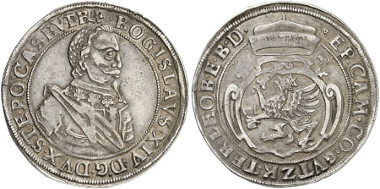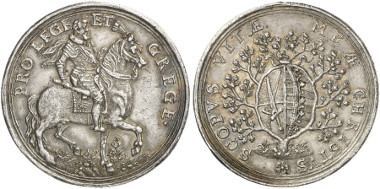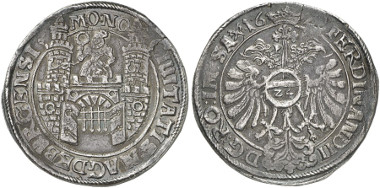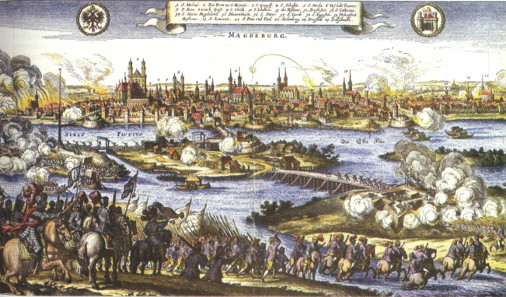translated by Annika Backe
On July 4, 1630, the Swedish army had landed at Usedom. On July 20, 1630, it entered Stettin. Gustavus Adolphus immediately visited the duke of Pomerania, Bogislav XIV, and compelled him – politely but firmly – to form an alliance with Sweden, part of which was the duke’s promise to pay high subsidies to the Swedish king.
Germany. Pomerania. Bogislav XIV. Reichsthaler, 1631, Stettin. Auction sale Künker 249 (2014), 1236.
As a pledge to pay on time, Gustavus Adolphus took the whole of Pomerania and thus acquired a ‘legal’ claim on a region that was vital for expanding the Swedish power on German imperial territory. The subsidies, after all, amounted to such great a sum that it was almost impossible for Duke Bogislav to pay them by specified date.
Gustavus Adolphus’ next target was the city of Magdeburg which Wallenstein had captured on behalf of the emperor. The Protestant administrator, Christian Wilhelm, who had been expelled in the course of events, supported the Swedes who entered Magdeburg on August 6, 1630.
Annexing the role of advocate of all Protestants in Germany, Gustavus Adolphus forced the Protestant estates to react in order to not cede the initiative to the Swedish king.
They met at a colloquy in Leipzig in the very same year, 1630. The outcome of this meeting was an ultimatum to the emperor, signed by all important electors and imperial estates, Protestant and Calvinist alike: if the emperor did not remedy all shortcomings caused by the Edict of Restitution and the imperial troops immediately the Protestant estates could not assume responsibility for any repercussions. As a matter of fact, that threat was an encoded declaration of war because the emperor had made it abundantly clear during the diet shortly before that he had no intention whatsoever of rescinding the Edict of Restitution.
For the first time in this war there was a united front of Protestant and Calvinist imperial electors. The estates intended to actively engage in military operations, thus becoming involved in the big war at last.
Germany. Saxony. John George I. Silver medal n. y. (by H. von Lünen). Auction sale Künker 247 (2014), 5938.
The plan was to assemble an army, to be commanded by John George of Saxony. Hans Georg von Arnim, a close ally and friend of Wallenstein, was charged with supervising the mustering and with commanding the fighting forces.
Germany. Greifswald. Lead emergency token of 4 ounces, 1631. Auction sale Künker 211 (2012), 3087.
The army of Arnim was ready for fight as late as spring 1631. His first opponent was not Tilly but Gustavus Adolphus. The Protestant estates ordered Arnim to prevent the Swedish army from advancing any further. Already in January 1631, the bad supply situation had forced the Swedish army to leave its winter quarters. It then captured Frankfurt an der Oder and Greifswald ((295)) and was currently standing at the Oder River headwater. The, strictly speaking not anti-Tilly, manoeuvers of the Protestant army nevertheless posed a dilemma to him. His troops were located in Mecklenburg and the Oder Valley, and the commander over Mecklenburg was Wallenstein. He steadfastly refused to supply Tilly with provisions as long as he did not receive payment not only in cash but also in advance. It means in effect that no provisions were delivered to the army at all. The soldiers starved, many deserted, and many let themselves be recruited by the approaching Protestant army. The fighting power of the Catholic army, therefore, dwindled away constantly.
In order to keep his troops more or less intact, Tilly had no alternative than to leave Mecklenburg. Yet Gustavus Adophus was advancing from the East. By then, the Swedish king had forced a second important imperial prince into an alliance: George William of Brandenburg. He finally held the entire North-Eastern part of the empire in his hands, thus divesting Tilly of his area of retreat. The Protestant army, led by Arnim, advanced from the South. Tilly did not want to engage in battle against him, either. The only option he had, therefore, was to conquer a rich city, for his men to make camp, regain their strength and gather courage. Magdeburg was a suitable candidate. It was easy to reach and rich enough to provide the troops with accommodation and provisions. And so Tilly led his army to the city gates and started a constant assault on May 17, 1631.
Germany. Magdeburg. Reichsthaler, 1628 (? last number not reliable). Auction sale Künker 246 (2014), 4224.
Magdeburg would have loved to be spared a siege. When the assault began the citizens begged the Swedish townmajor to surrender the city to Tilly. But the commander remained firm in that matter. He did not want to give the Catholic army any chance of recovering.
Johann Philipp Abelin, Sack of Magdeburg 1631, 17th century.
On May 20, 1631, Magdeburg fell. The soldiery, starving and exhausted, flocked into the city, it killed, pillaged and raped. Nothing could stop the atrocities of the army.
Not even Tilly managed to prevent his soldiers from annihilating the city that should have been their new quarters. Amidst this orgy of violence a fire broke out. It is not clear whether the fire was a result of the sack or if the Swedish townmajor had ordered to start the fire to prevent Tilly’s army from making camp in Magdeburg.
The city burnt to the ground. Magdeburg had been compared with the Protestant Virgin before, who refused to be taken by the imperial suitor. Now, the city was compared with Roman Lucretia who took her own life after the rape in order to fuel her relatives’ desire for vengeance even more effectively. Magdeburg became a torch, a signal to the entire Protestant world to take sides.
In the next episode you are going to read how, after Magdeburg had been lost, Gustavus Adolphus retaliated and taught Tilly the meaning of fear.
All parts of the series can be found here.










